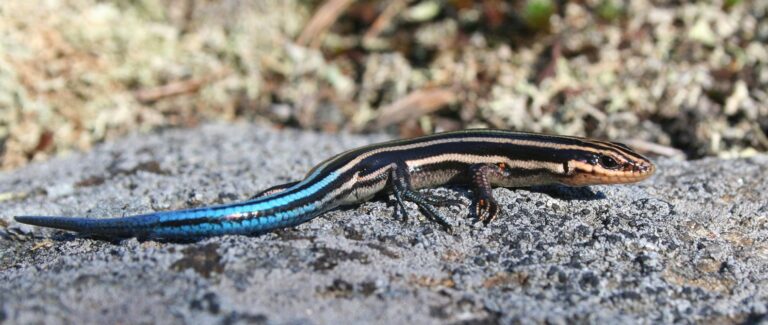Saving Skinks!
By Jenn LeMesurier.

The Common Five-lined Skink is listed as a Species at Risk in Ontario, and Muskoka provides habitat to this unique species. Specifically, Five-lined Skinks are found in rock barren environments at the southern edge of Muskoka.
The Common Five-lined Skink is the only lizard native to Ontario and is not often seen due to their quick nature and ability to camouflage. Juveniles and some adults can be readily identified by five cream coloured stripes that extend down the length of their green-black bodies. The species becomes more uniformly bronze with age, though hatchlings and juveniles have bright blue tails. They can grow up to 21 cm in length and, while similar in body shape to salamanders, they have scales and claws which sets them apart.
Skinks in Muskoka are typically found in forest openings, specifically large rocky outcrops, seeking shelter under rocks or tree stumps. Females typically lay between 8-10 eggs in the early summer in a nest under cover (e.g. rotting log). They will leave their nest to bask in the sun, and then return use their bodies to warm their eggs which hatch in the late summer. The hatchlings will be about 3 cm in length.
On cool summer mornings, it’s possible to find Skinks basking in the sun, but most often they are found hiding under cover. They typically hunt in the leaf litter and can even climb trees to escape predators!
The really neat adaptation that Five-lined Skinks have is that their bright blue tail can break off if grabbed by a predator. When the tail breaks it will thrash about for a few seconds which distracts the predator for just long enough that the Skink can escape. Although a new tail will grow back with time, the Skink will have lost much of the fat reserves on which it relies to survive hibernation in the winter.
Five-lined Skinks are listed as a species of Special Concern in Ontario, which means they live in the wild, but could become threatened or endangered. The biggest threats to Skinks in Ontario are the loss and disturbance of habitat. Development and population increase in cottage country has a big impact on species at risk. The removal of cover objects has been observed specifically in the Southern Shield population as rocks are moved in high traffic natural areas and woody debris is moved for firewood. Removal of these objects during nesting season is particularly negative. Illegal collecting for pets, traffic mortality and increased predation all pose significant threats to Five-lined Skinks in Ontario.
So…what can you do?
Protect rock barren habitat for species at risk by keeping development out of these sensitive areas. Maintaining cover objects like rocks and logs that Skinks utilize for refuge is one of the simplest things we can do. When you’re spending time outdoors, remember that we need to respect the need for wildlife to have space in nature. Please don’t build inukshuks along hiking trails, keep your pets on a leash, and maintain natural habitat areas around your own property. You could work to create habitat for Five-lined Skinks on your own property by using coverboards or leaving brush piles and be sure not to disturb known nesting sites.
If you have interest in recording your wildlife sightings, use the iNaturalist app to take photos and notes on the species you come across while out exploring – including Five-lined Skinks! The data collected using this application is used by citizen scientists and environmental professionals alike.
If you’re lucky enough to capture a photo of a Five-lined Skink, be sure to share the sighting. After all, education and awareness for this species is important in helping them thrive!
Jenn LeMesurier is an Ecologist at RiverStone Environmental Solutions Inc. and is a member of the Muskoka Watershed Council.
